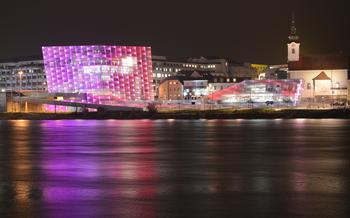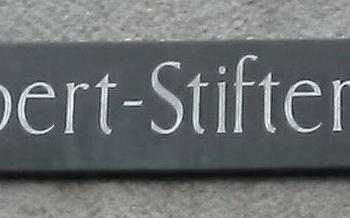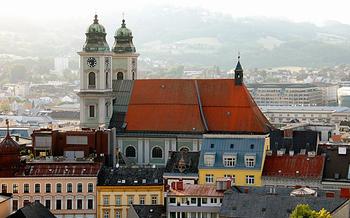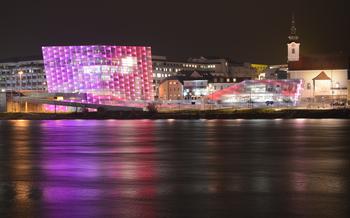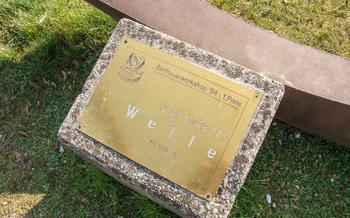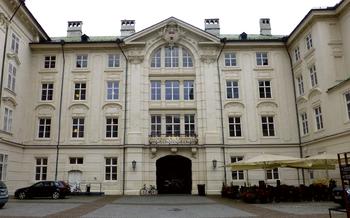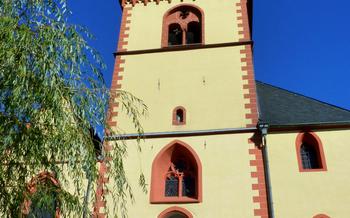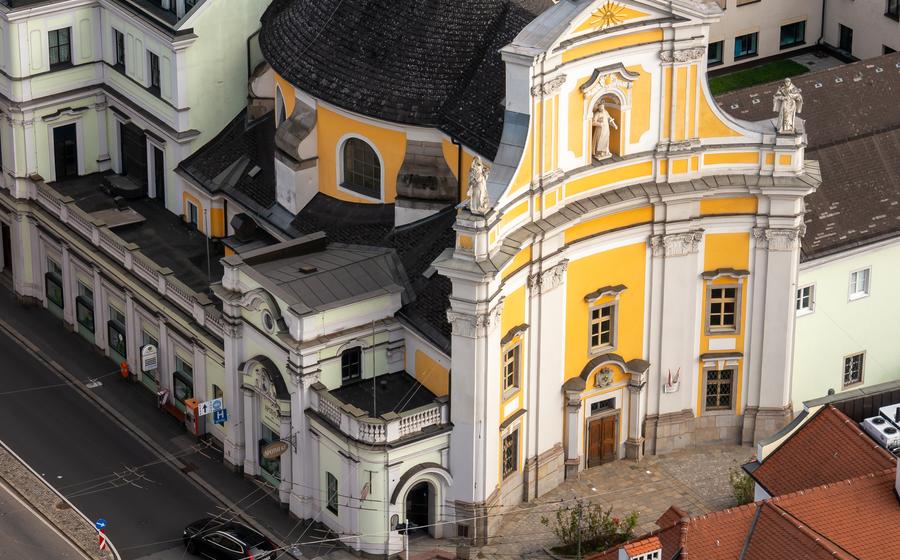
Mariendom (New Cathedral)
- The Mariendom in Linz
- Exploring the Cathedral's History
- Marveling at the Gothic Revival Architecture
- Admiring the Impressive Interior
- Stepping into the Past: The Catacombs
- Witnessing the Organ's Divine Melodies
- Finding Spiritual Peace in the Chapel
- Experiencing the Christmas Market
- Discovering the Bishop's Palace
- Attending a Mass or Service
- Exploring the Surroundings: Old Town Linz
- Tips for Photographers
- Accessibility and Practical Information
- Insider Tip: Unveiling Hidden Details
The Mariendom in Linz
The Mariendom, or New Cathedral, is a prominent symbol of Linz, Austria, and a must-see attraction for visitors to the city. Its neo-Gothic grandeur and spiritual significance make it a compelling destination for history buffs, architecture enthusiasts, and pilgrims alike.
Constructed between 1862 and 1935, the Mariendom is a testament to the city's deep-rooted Catholic faith and its emergence as a significant religious center. The cathedral's imposing size and elaborate ornamentation reflect the desire of the Linz diocese to create a magnificent structure that would rival the grandeur of other Gothic cathedrals across Europe.
Architecturally, the Mariendom showcases a blend of Gothic Revival and Neo-Gothic styles, characterized by its pointed arches, intricate tracery, and soaring spires. The cathedral's facade features a richly decorated main portal adorned with sculptures of saints, while its interior boasts stunning stained glass windows, elaborate altars, and meticulously crafted sculptures.
Beyond its architectural splendor, the Mariendom holds immense cultural and historical significance for Linz. The cathedral has played a pivotal role in the city's religious and cultural life, serving as a venue for important ceremonies, festivals, and concerts. Its construction also marked a period of economic growth and prosperity for Linz, transforming it into a thriving industrial center.
Exploring the Cathedral's History
The Mariendom's story began in the late 19th century when Linz's growing Catholic population necessitated a larger cathedral. Prominent architect Franz Statz was entrusted with the design, and construction commenced in 186Statz's vision drew inspiration from the Gothic Revival style, then popular in Europe. Over four decades of meticulous work ensued, with the cathedral's consecration finally taking place in 193
The Mariendom's construction was not without its challenges. Funding limitations and World War I caused delays and modifications to the original plans. Nevertheless, the result was a stunning edifice that seamlessly blended Gothic traditions with modern construction techniques. Today, the Mariendom stands as a testament to the determination and artistry of those who brought it to life.
Throughout its history, the Mariendom has played a pivotal role in Linz's religious and cultural landscape. It has witnessed countless baptisms, marriages, funerals, and other significant events in the lives of local Catholics. It has also hosted numerous concerts, exhibitions, and lectures, showcasing its versatility as a spiritual and cultural center.
Notable milestones in the Mariendom's history include its elevation to the status of a minor basilica in 1965 and its inclusion on the list of protected historical monuments in 197These recognitions underscore the cathedral's immense cultural and architectural significance, both regionally and nationally.
Marveling at the Gothic Revival Architecture
The Mariendom's architectural style is a prime example of the Gothic Revival movement that swept through Europe in the 19th century. This style sought to revive the grandeur and spirituality of medieval Gothic architecture, adapting it to the needs and sensibilities of the modern era.
The Mariendom's architects, Franz and Ferdinand Statz, drew inspiration from some of Europe's most iconic Gothic cathedrals, such as Cologne Cathedral and Notre Dame de Paris. They employed traditional Gothic techniques and materials, such as ribbed vaults, flying buttresses, and intricate stone carvings. The result is a stunning edifice that exudes both historical authenticity and a distinctly modern elegance.
One of the most striking features of the Mariendom's exterior is its two asymmetrical spires. These slender, needle-like structures soar high above the city skyline, reaching a height of over 130 meters. The spires are adorned with intricate carvings and delicate pinnacles, creating a sense of awe and grandeur.
The Mariendom's buttresses, which support the weight of the vaulted ceilings and walls, are another notable architectural highlight. These massive structures are not merely functional but also highly decorative, featuring intricate carvings and sculptural elements that add depth and interest to the cathedral's exterior.
Overall, the Mariendom's Gothic Revival architecture is a testament to the skill and dedication of its architects and builders. It is a harmonious blend of historical tradition and modern innovation, creating a sacred space that inspires and uplifts the soul.
Admiring the Impressive Interior
The interior of the Mariendom is a testament to the grandeur of Gothic Revival architecture. The vast nave, stretching towards the altar, is a symphony of light and space, with vaulted ceilings that seem to touch the heavens. The intricate stained glass windows, a kaleidoscope of colors, depict biblical narratives and saints, casting a warm glow on the interior.
Elaborate altars and sculptures adorn the cathedral, each a masterpiece of craftsmanship. The high altar, a focal point of the interior, is a stunning work of art, intricately carved with biblical scenes and crowned by a resplendent golden canopy.
A unique feature of the Mariendom is the Pöstlingberg Madonna, a revered statue of the Virgin Mary. Carved from wood in the 15th century, the statue exudes an aura of serenity and devotion, attracting pilgrims from near and far.
The Mariendom's interior is a harmonious blend of architectural grandeur, artistic masterpieces, and spiritual symbolism. It invites visitors to pause, reflect, and marvel at the beauty and devotion that emanate from every corner of this sacred space.
Stepping into the Past: The Catacombs
The Mariendom holds a secret beneath its grand façade—a network of catacombs that offer a glimpse into the city's past. These underground tunnels were once used as burial chambers and ossuaries, and today, they serve as a fascinating and eerie attraction for visitors.
Guided tours of the catacombs are available, taking you on a journey through time as you explore the dimly lit tunnels. Along the way, you'll see centuries-old tombs, inscriptions, and skeletal remains, providing a tangible connection to Linz's rich history.
Among the most intriguing discoveries made during excavations in the catacombs was the well-preserved body of a young woman, believed to be from the 17th century. Her remains, remarkably intact, offer a glimpse into the lives and customs of Linz's past inhabitants.
The atmosphere in the catacombs is palpable, with a mix of awe and reverence. The silence is broken only by the gentle footsteps of visitors and the occasional drip of water from the damp walls. It's a place that invites reflection on the fragility of life and the enduring legacy of the past.
Witnessing the Organ's Divine Melodies
Within the Mariendom's hallowed halls, a symphony of divine melodies unfolds, courtesy of its magnificent organ. Constructed by the renowned organ builder Matthäus Mauracher in 1968, this awe-inspiring instrument boasts 3,898 pipes, ranging from delicate whispers to thunderous roars. Each note reverberates through the vast cathedral, filling the air with a celestial aura that transports listeners to a higher realm.
The organ's intricate craftsmanship is a testament to Mauracher's mastery. Its imposing facade, adorned with intricate carvings and gilded embellishments, commands attention. The console, a masterpiece in itself, features an array of stops, pedals, and keyboards, allowing the organist to conjure a kaleidoscope of sounds.
Regular concerts and recitals grace the Mariendom with their enchanting melodies. Talented organists from around the world showcase their virtuosity, performing both classical masterpieces and contemporary compositions. The acoustics of the cathedral are truly remarkable, allowing every note to soar and resonate, enveloping the audience in a symphony of divine harmonies.
Attending an organ concert at the Mariendom is an experience that transcends the ordinary. As the organist's fingers dance across the keys, the music fills the air, washing away earthly concerns and elevating the soul to celestial heights. It is a moment of pure bliss, where the power of music and the grandeur of the cathedral intertwine, creating an unforgettable spiritual experience.
Finding Spiritual Peace in the Chapel
Within the grand walls of the Mariendom, a serene haven awaits in the form of its dedicated chapel. Located off the main nave, this sacred space exudes an atmosphere of tranquility and devotion. Here, visitors can retreat from the bustling city, seeking solace and reflection.
The chapel serves as a focal point of worship for the local Catholic community. Its elegant altar, adorned with intricate carvings and delicate artwork, invites contemplation and prayer. The soft glow of candlelight casts a warm and welcoming ambiance, creating an ideal setting for personal devotion.
Beyond its religious significance, the chapel holds artistic and historical value. Its stained glass windows depict scenes from the Bible, narrating stories of faith and hope. The meticulous attention to detail in the chapel's design and decoration reflects the deep reverence and craftsmanship that went into its creation.
Whether seeking spiritual solace or admiring its artistic beauty, the chapel within the Mariendom offers a unique and enriching experience. Its serene atmosphere encourages visitors to pause, reflect, and find moments of inner peace amidst the grandeur of this remarkable cathedral.
Experiencing the Christmas Market
The Mariendom's enchanting allure extends beyond its religious significance, transforming the surrounding area into a festive wonderland during the Christmas season. A vibrant Christmas market envelops the cathedral, filling the air with the sweet aroma of roasted chestnuts and mulled wine. Local vendors showcase their traditional crafts, offering unique gifts and souvenirs that capture the spirit of the season. Artisans display their handmade ornaments, intricate wooden carvings, and delicate lacework, each piece a testament to Linz's rich cultural heritage.
As night falls, the market transforms into a magical realm illuminated by twinkling lights and the soft glow of lanterns. Culinary delights abound, tempting visitors with freshly baked pastries, gingerbread cookies, and roasted meats. The sounds of cheerful music and laughter mingle with the gentle hum of the Christmas market, creating an atmosphere of warmth and camaraderie. Special events and performances add to the festive cheer, with choirs singing traditional carols and children eagerly awaiting the arrival of Santa Claus.
For those seeking a truly immersive Christmas experience, the Mariendom Christmas market is an unmissable attraction. It offers a captivating blend of local traditions, festive ambiance, and the opportunity to connect with the vibrant spirit of Linz during this magical time of the year.
Discovering the Bishop's Palace
Adjacent to the Mariendom stands the Bishop's Palace, an architectural gem that has been intricately linked to the cathedral's history. Built in the 18th century, the palace exudes a stately presence with its elegant Baroque facade. Guided tours provide a glimpse into the lavish interiors, adorned with opulent chandeliers, intricate frescoes, and grand staircases.
The Bishop's Palace holds great significance as the residence of the Bishop of Linz and serves as the administrative center of the diocese. Over the centuries, it has witnessed countless religious ceremonies, meetings, and gatherings, playing a pivotal role in the spiritual and cultural life of Linz.
Visitors can immerse themselves in the palace's rich history through informative exhibitions that showcase religious artifacts, historical documents, and artwork. These exhibitions shed light on the deep connection between the palace and the Mariendom, highlighting their shared role in shaping Linz's religious and cultural heritage.
Attending a Mass or Service
As a sacred space, the Mariendom invites visitors to immerse themselves in its spiritual atmosphere by attending a mass or service. Whether you're a devout Catholic or simply curious about religious traditions, this experience offers a profound insight into the local culture and community.
Mass Times and Schedules:
Masses are typically held throughout the week and on Sundays, with varying schedules depending on the season. To ensure your visit aligns with your preferences, check the Mariendom's official website or contact the parish office for precise mass times.
Dress Code and Protocols:
While there's no strict dress code for attending a mass, it's customary to dress respectfully, avoiding shorts, tank tops, or excessively casual attire. During the service, visitors are expected to follow local customs, such as standing for the Gospel reading, kneeling during prayers, and receiving communion if they are Catholic.
Spiritual and Cultural Traditions:
Participating in a mass or service at the Mariendom not only allows you to witness the grandeur of the cathedral but also to experience the deep-rooted religious traditions of the local community. The service is conducted in German, but visitors can follow along with the readings and prayers in English through provided booklets or apps.
Tips for Participating Respectfully:
To ensure a respectful and meaningful experience, here are a few tips to keep in mind when attending a mass or service at the Mariendom:
-
Arrive a few minutes early to find a seat and settle in before the service begins.
-
Be mindful of your surroundings, avoiding loud conversations or distractions.
-
Follow the lead of those around you in terms of standing, kneeling, and other gestures.
-
If receiving communion, approach the altar with reverence and respect.
Exploring the Surroundings: Old Town Linz
Beyond the Mariendom's awe-inspiring presence, immerse yourself in the charm and history of Linz's Old Town. This captivating neighborhood, located just a stone's throw from the cathedral, offers a treasure trove of architectural wonders, cultural attractions, and culinary delights.
Stroll along the cobblestone streets and discover hidden courtyards, each with its own unique character. Admire the pastel-colored facades of medieval buildings, remnants of a rich past that blend seamlessly with modern architecture. Don't miss the stunning Old Town Hall, with its intricate Gothic details and towering clock tower, a symbol of Linz's civic pride.
Explore the many museums and galleries that showcase the city's artistic and cultural heritage. Visit the Linz Art Museum to admire a diverse collection of modern and contemporary art, or delve into the history of Upper Austria at the State Museum. For a unique perspective, take a guided tour of the historic Landhaus, the seat of the Upper Austrian Parliament, and marvel at its grand halls and chambers.
Indulge in the local culinary scene as you savor traditional Austrian dishes at cozy restaurants and cafes. Sample the famous Linzer Torte, a delectable pastry filled with red currant jam, or try some of the region's renowned craft beers. For a truly authentic experience, visit the bustling farmers' market, where you can find fresh produce, handmade crafts, and local delicacies.
Whether you're a history buff, an art enthusiast, or simply a curious traveler, Linz's Old Town offers an unforgettable journey through time and culture. From the grandeur of the Mariendom to the hidden gems waiting to be discovered, this vibrant neighborhood promises an enriching experience for all who wander its streets.
Tips for Photographers
The Mariendom's architectural grandeur and intricate details make it a photographer's paradise. To capture its essence, consider using a wide-angle lens to encompass the soaring spires and buttresses. Experiment with different angles to highlight specific features, such as the intricate carvings on the facade or the dramatic play of light and shadow on the exterior. A tripod can help steady your camera for sharp shots, especially in low-light conditions.
When shooting the interior, focus on the grand nave and vaulted ceilings, utilizing leading lines to draw the viewer's gaze towards the altar. The stained glass windows are a must-capture, so position yourself to take advantage of the natural light filtering through them. To capture the intricate details of the sculptures and altars, use a macro lens to bring out their exquisite craftsmanship. Remember to experiment with different shutter speeds to capture the movement of the organ's bellows or the flickering candles, adding a sense of dynamism to your shots.
Accessibility and Practical Information
The Mariendom is committed to inclusivity and offers accessibility features for visitors with disabilities. Wheelchair ramps and elevators provide convenient access to various areas of the cathedral, ensuring that everyone can enjoy its grandeur.
Admission to the Mariendom is free, allowing visitors to explore its beauty and history without any financial burden. Guided tours are available for those seeking a deeper understanding of the cathedral's significance and architectural features. These tours are conducted by knowledgeable guides who share fascinating insights and anecdotes, bringing the Mariendom's story to life.
To plan your visit, check the official website of the Mariendom for updated information on mass times, guided tour schedules, and any special events or exhibitions. The website also provides contact details for inquiries, ensuring a seamless and enjoyable experience for all visitors.
Insider Tip: Unveiling Hidden Details
The Mariendom holds many secrets waiting to be discovered. One fascinating legend tells of a "hidden treasure" concealed within the cathedral's walls. While its exact location remains a mystery, many believe it to be a valuable relic or artwork from the cathedral's early days.
For a unique perspective, venture into the hidden crypts beneath the cathedral. These atmospheric underground chambers were once used for burials and offer a glimpse into the Mariendom's rich history. Guided tours are available, providing insights into the lives of those laid to rest here.
To fully immerse yourself in the spiritual and cultural significance of the Mariendom, participate in one of the special events or workshops held throughout the year. These events range from traditional religious ceremonies to concerts and art exhibitions, offering a deeper connection to the cathedral's heritage.
For an authentic dining experience, head to one of the local restaurants recommended by the locals. Savor traditional Austrian cuisine while soaking in the charm of Linz's historic center. The flavors and hospitality will leave a lasting impression, completing your journey to the Mariendom.


